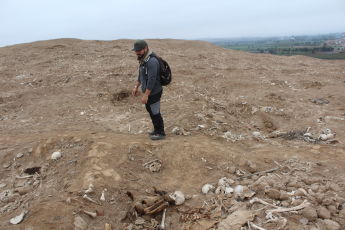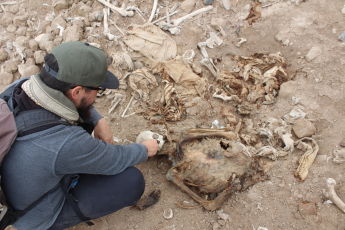January moves into February and then into March and the devastation continues. Travel to the north is severely restricted, with roads damaged and major bridges destroyed. To the south, the river Mala and the Omas valley have unprecedented floods, and roads are swept away. Further south, in the Cañete and Chincha valleys, the rivers are more sedate and the roads are passable. Lima’s water supply is secure again and I am keen to get out of town.
The river valley of Cañete lies forty-five kilometres south of the Rio Mala, three days journey for man and llama, running down the coast to the modern town of the same spanish name. The river is one of the largest on the central coast and comes from Ticllacocha, 120 kilometres inland in the land of the Yauyos near Tanta, at 4600 metres above sea level.
Cañete is located in the centre of a broad fertile plain irrigated with water from the river valleys. This plain is dotted with the traces of pre-Inca activities.
Close by the sea, on a promontory looking over a long beach at Cerro Azul, the Blue Hill, is a fortress, described by Pedro de Cieza as “. . . the most beautiful and ornate citadel to be found in the whole kingdom of Peru, set upon great square blocks of stone, and with very fine gates and entrance ways . . . from the top of this royal edifice a stone stairway descends to the sea.”
Pedro de Cieza’s La Crónica del Perú was published in Seville in 1553, and he took notes and wrote as he travelled with the Spanish army throughout Peru and Chile. What he described here was soon destroyed.
A few rows of Inca stonework remain – the rest has been plundered for colonial buildings. But walking round the dusty red hillside I find thick wooden timbers poking through the sand, quite extraordinary to see in the bare scrub desert today. There are layers of ancient refuse protruding through the soil, including shellfish, cloth and human bone. I follow a steep path down to a tiny pebble beach. On my left there is half a corpse with some cloths and cords lying by a wooden platform projecting from the slope. Down on the beach I turn to look up at the steep hillside above. A cascade of human bones, cloths and cords trails down the slope.
The fortress was a post conquest Inca addition to the large complex of ceremonial and administrative buildings built by the Guarco who occupied this land. It is positioned on the very top of the hill as a potent symbol of Inca presence, tall walls of golden adobe that can be seen standing up righteously from much of the coastal plain.
A few kilometres to the south is the temple complex of Vilcahuasi, “place of the holy”, an unexcavated group of up to twenty platform mounds. Modern farming is slowly nibbling away at the edges of the archaeological site.
Inland from Cerro Azul, at the northern edge of the valley, there is a 150 hectare hillside settlement called Cerro d’Oro, the Hill of Gold, which was occupied for 1600 years before the Spanish came. Giant embankments stand close to the hill, suggesting defensive fortifications, broad and strong enough to support modern farm roads that run along the top.
In the beach resort at Cerro Azul I find a taxi and ask the driver to take me to “the Japanese Cemetery, San Luis”. The driver takes me to the end of the tarred road, and I follow the track as it contours above a farmstead where a woman is hanging washing beneath a hanging burgmansia. Chickens scratch under the washing line and a burro chews hay morosely in a corner of the yard. A small boy maybe four years old, calls out to me from below, in spanish, “what is your name? Where are you going? Do you have money?”

I am going to visit Charley Clinton, an archaeologist working on a dig at Cerro d’Oro. On the hillside above me I can see lines of small round adobitos, mud bricks, the remains of walls, peering through the sand. Ahead by the side of the track is a giant wall, three metres high and half a metre thick, made of slabs of clay known as tapia, pressed in moulds, each block the size of a hotel minibar.
At the end of the track is a bend and I am facing a Nippon buddhist arch and tall white walls. Looking through the gateway I see a central monument marked with a cross and Japanese script, and 20 plain white headstones standing in a small area of raked gravel. Here are buried the remains of the first Japanese immigrants who worked and died on the Casa Blanca, La Quebrada and Santa Barbara haciendas, or plantations. They were recruited in Japan, brought across the Pacific by boat and unloaded in 1899 at the pier of Cerro Azul, a few kilometres away.
To one side of the cemetery is another three metre high wall, this time made of the round adobitos. I can clearly see the marks of the fingertips working the wet clay mortar between the bricks.

“Hey there man!”
Charley is striding down the hill to meet me, in a short sleeved jacket with multiple pockets, washable tan trousers and rugged boots. We shake hands.
“Look at this!”
He points to a small niche in the wall in which were four or five femurs.
” That,” he says with a massive grin, “Is nothing. You are gonna love this!”
We walk up the hill of light sandy soil which is scattered with occasional potsherds and sea shells, broad cockles coated with barnacles. I pick up a hand-sized smooth round stone of a light green colour, almost translucent.
“This is interesting. Is it some form of tool?”
” Probably. Diego is very interested in the green stones. He thinks the source is close to here.”
As we continue upwards there are skulls at the sides of the path, outcrops of adobitos mortared together in tidy rows, or rolling down the hillside in loose piles. And then we come over the brow of the hill and there before us is a plain scattered with bones and skulls spilling out of grave-robbers’ pits.
In and among the bones are cotton cloths in which the bodies had been wrapped, the plaited fibre cords that had tied the mummy bundles, discarded grave goods, spherical black pots with narrow necks and two handles, thick round necks from carabaylos, and occasional thin creamy fragments with multicoloured decorations, black and red and a luscious dark purple colour. This is a ransacked cemetery, and the canes used by the robbers to probe the ground and their discarded water bottles are also scattered about.
After walking through this for several minutes, past hundreds, even thousands of disinterred skeletons, we reach a group of elevated platforms rising above the plain.
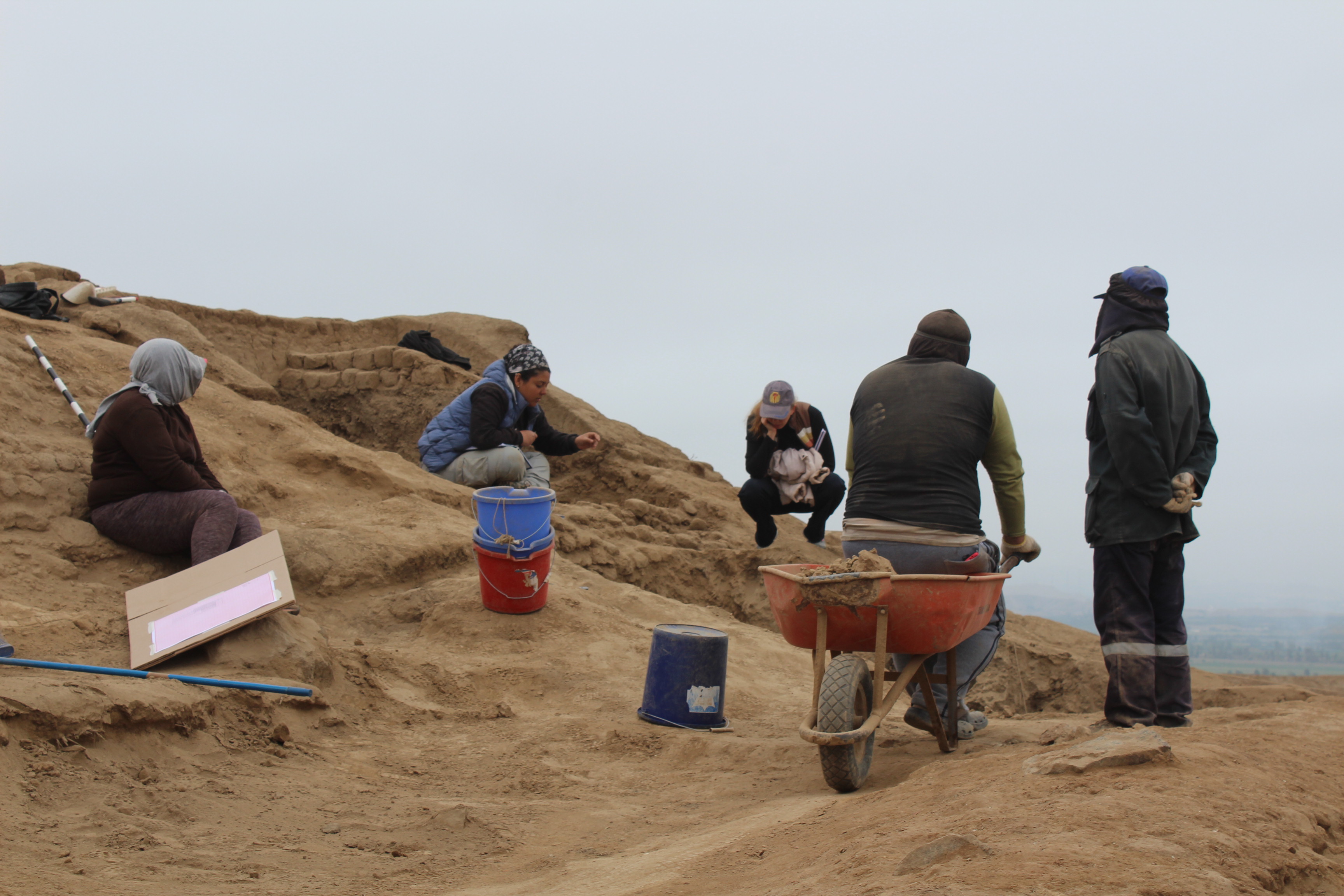
Half a dozen diggers are seated at the upper end of a gently sloping mound where they have revealed small rooms with upper walls of smooth clay tapia, whilst lower down the sides reveal adobito walls.
“Thats what I have been cleaning out today” says Charley, pointing to a conical funnel of adobitos sunk into the floor of one of the rooms, “and in the bottom I found a shark’s tooth.”
The chief digger, with a luxuriant black beard and a silver earring, speaks with the characteristic lisp of a Spaniard as he takes me on a quick tour of the site.
“We have been working here for some years, and last year we completed the excavation of some residential areas.This year we started to dig at what we thought was a huaca, a religious or ritual site.”
“What we found in previous years suggests a big settlement with lots of monumental adobe buildings, including houses and funerary structures, dating back to 550-850 CE. We are calling this the Cerro d’Oro period. Towards the end of that we think the Wari, from the southern highlands of Tihuanuco, were here. We found burials with elaborate funerary bundles and distinctive Wari textiles, which have also been found nearby in the valley at Huaca Malena. Then we have a later cemetery and residential complex from 1100 CE which we are calling Guarco, later occupied by the Inca who defeated the Guarco here, according to chroniclers, shortly before the Spanish Conquest.”
“Looking round the site,” he points to some walls a little further north, outlined against the grey sky, “you can see that there is a lot of tapia, large blocks of pressed clay, and that is the more recent period, Guarco. But elsewhere on the site,” he swung round and indicates a hillock twenty metres away, where a wall had collapsed into a heap of rounded bricks, “we have the adobitos, which are probably indicative of Cerro d’Oro.”
“And here, we have these tapia walls, and directly underneath them, the adobitos. So it looks as if the later arrivals added their own layer.”
We are looking down a rectangular hole like a well shaft, sunk through layers upon layer of neatly lined adobitos like bookshelves.
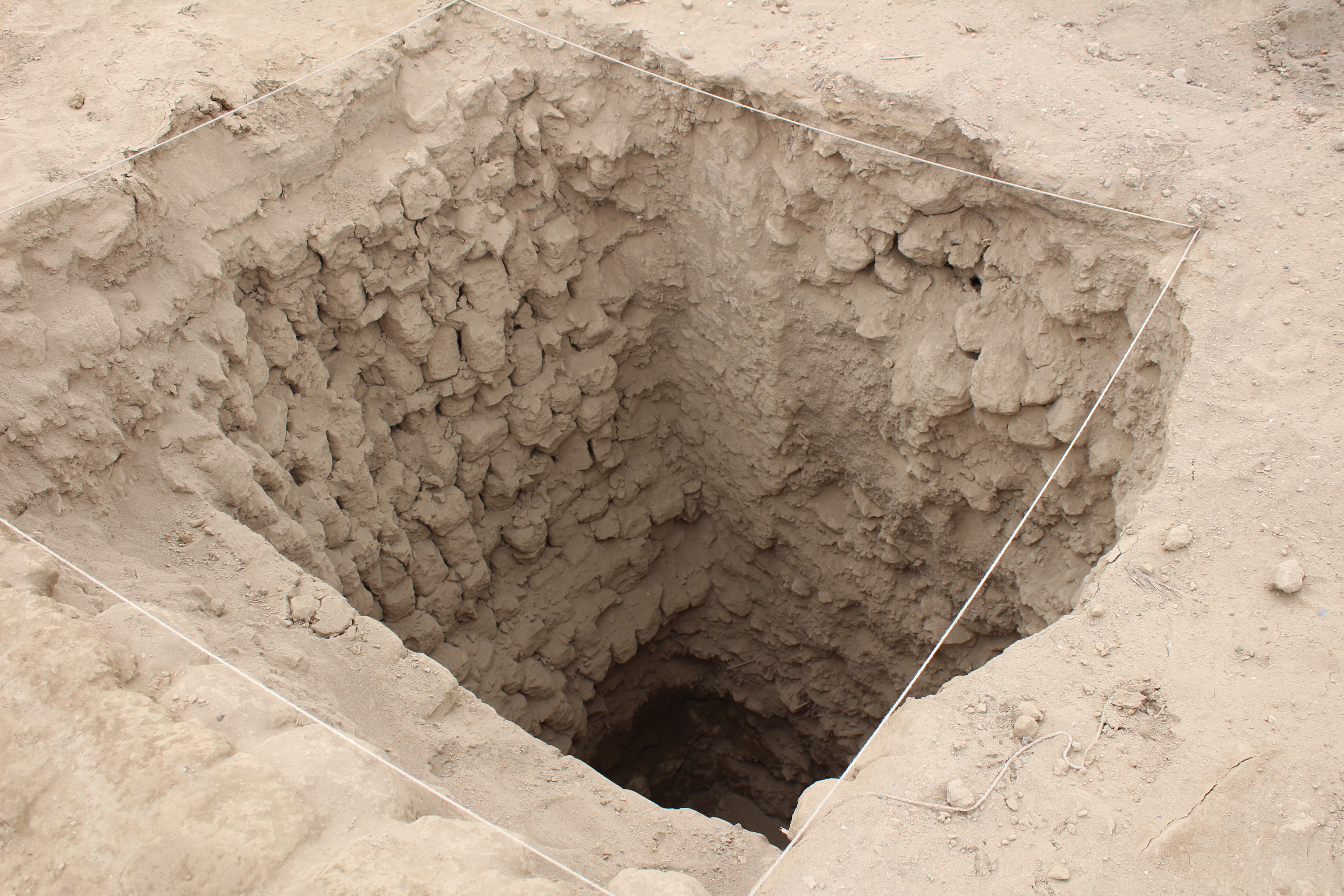
“And we keep going down, in this area, and we are finding a floor, and then another floor, one beneath the other. We have gone down five metres and not reached the bottom.”
Beyond the shaft the excavators have revealed are several narrow rooms with tidy walls, and the necks of giant ceramic jars can be seen protruding above the surface.
“We have not reached the bottom there, but on this side, we have a thick layer of fine sand from the beach which lies above the floor of a small side chamber, and under the sand we have found tiny fish bones. Maybe it was a storage pit for something like dried anchovies.”
“Because of its elevation, its position, it seems like a place of status and ritual,” he continues. “But it was being used to store food, and in vast quantities. So we are thinking that it could have been a centre for feasting, and the food was distributed from here to the people.”
A small collection of found objects is spread out on the ground, a human tooth, a stingray tooth, some smooth stones, and a wooden object like a spinning top. Charley is particularly excited by the stingray tooth.
“I am an ethnobotanist, that’s my thing, plant and animal remains. Camila over there,” he points to a student writing in a notebook, with a plastic bag of potsherds beside her, “she can tell you all about these ceramic pieces. Juan is the textile man.”
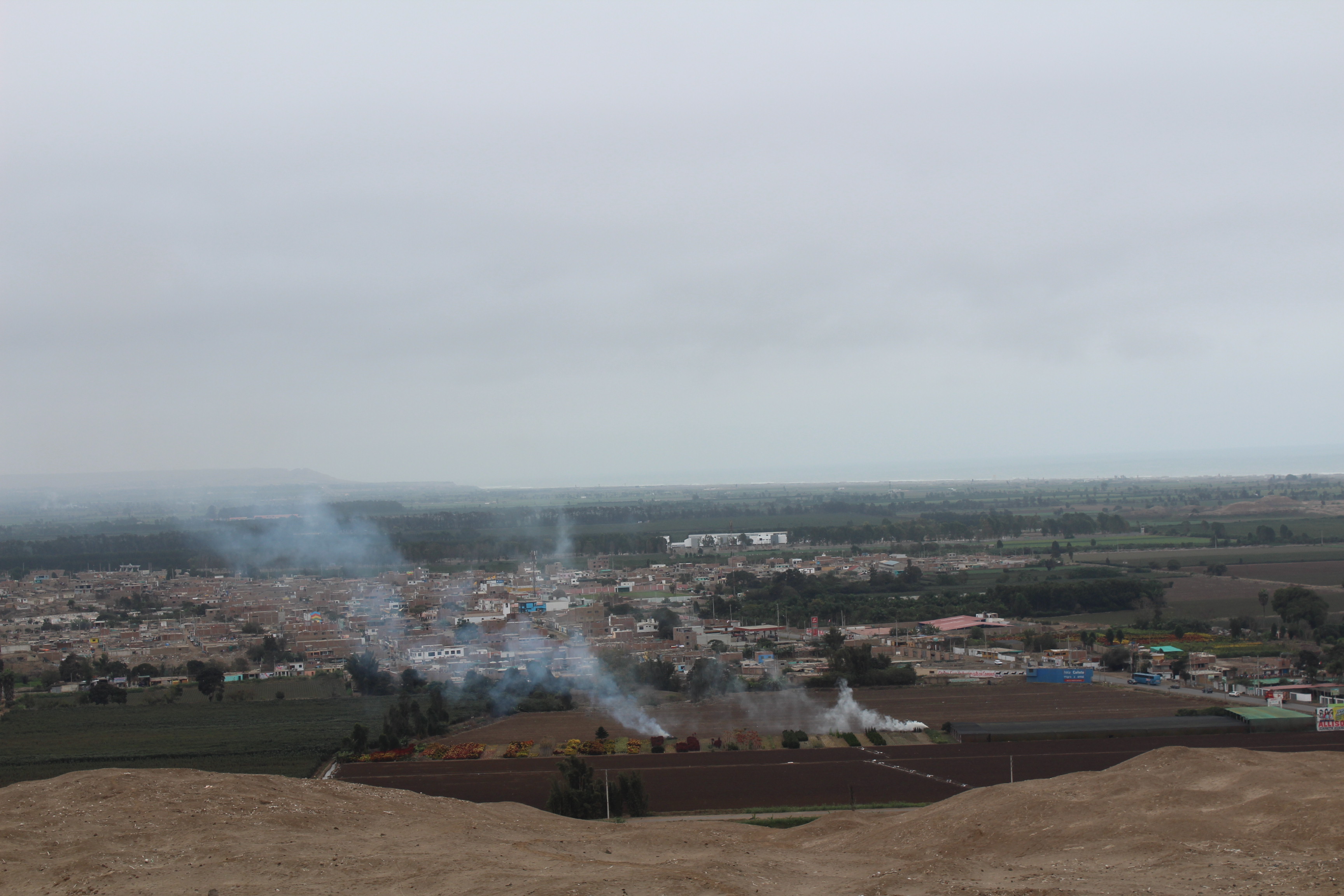
Below what would seem to be the foot of the huaca is a large flat area.
“We imagined that this was a huaca and we visualised this level space as a plaza for gatherings. But we are finding some walls and rooms in a dig down at the end,” says Charley.
The dig was about to pack up for year.
“We have not got many answers from this year’s work, but we have some interesting questions. That’s how it often works. We will be back next year. We get just a few weeks to work on the site.”
Charley takes me across the hillside away from the huacas.
“So we found a mummy, a dried out corpse down here, well half a corpse really. We are calling him Señor Medio (Mister Half).”
After walking a few hundred metres we are looking at another extended plain of sandy pits disgorging bones and skulls and strips of cloth.
“It looks like the Somme.”
“Yes. If I was not an archaeologist I would have nightmares about this.”
“I would not want to be up here at night.”
“But we think people are coming up here, collecting bones.”
“For fertiliser?”
“Who knows. For rituals, or to sell. But we can see the footprints. You can see the prints of expensive walking boots, that’s the archaeologists, but then there are people walking round here in flip-flops.”
There are cycle tracks in the sand, and someone has arranged a giant heart made out of skulls and arm bones, surrounding the letters VT. I wonder how their loved one responded to this gesture.
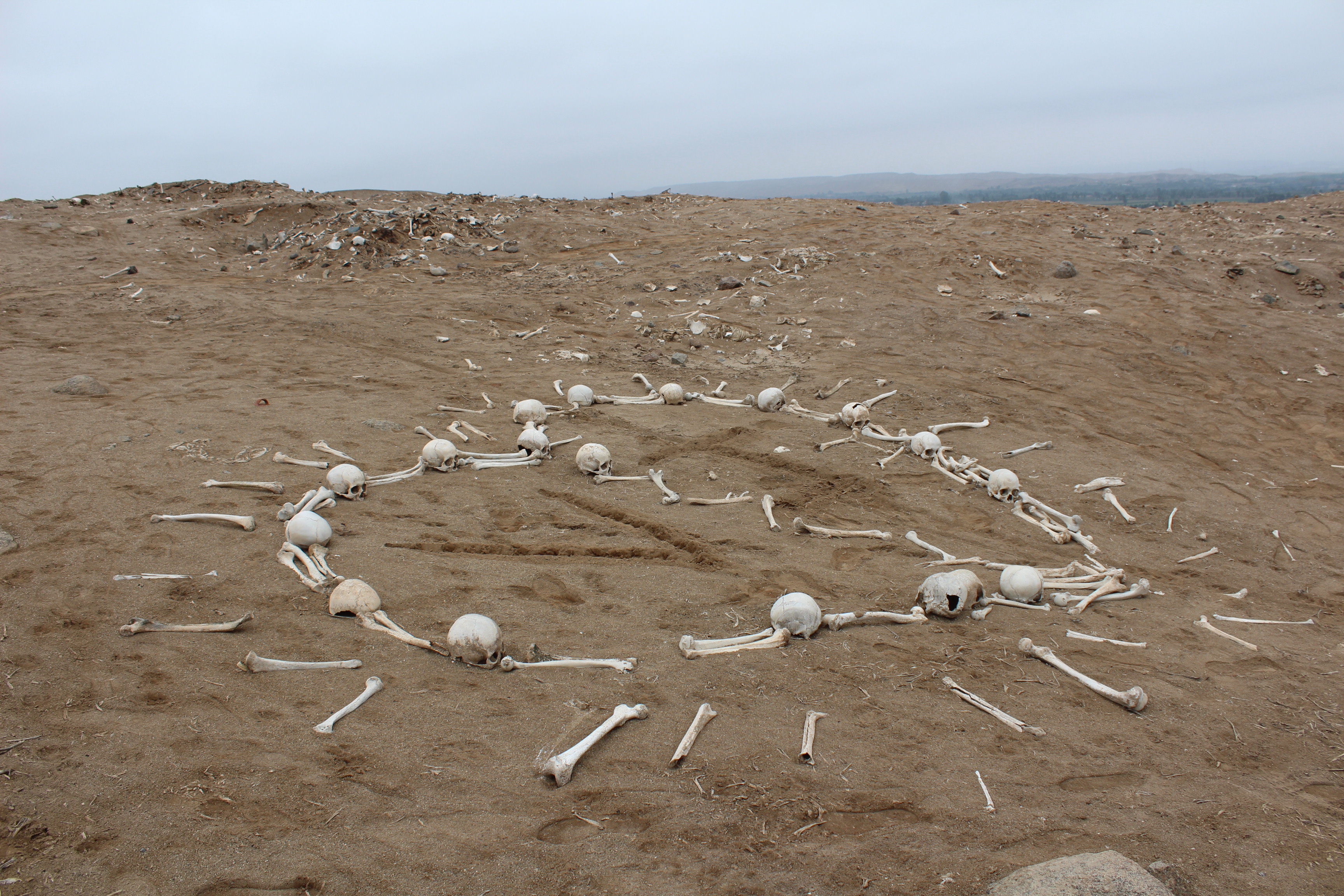
We walk between two parallel walls, ten metres apart, which though sunk in sand appear to be several metres high. After a minute one wall stops, and the other takes a ninety degree turn to the right.
“Such big walls, but they are not enclosing anything?”
There is a space the size of several football pitches, surrounded by tall walls on three sides.
“There is probably a lot in there,” says Charley, “it is just covered over. If you look closely you can see some remains.”
Sure enough, there are skulls and thigh bones resting in hollows. But it does not compare to the uprooted charnel house outside the walls.
Scattered amongst the bones are some large fragments of polychrome ware with characteristic geometrical designs, black ware vessels, and the yellow orange necks of large vessels. In one pit is a closely wrapped bundle in white cotton, the thickness of an upper arm.
“What’s this, a child mummy bundle?”
Charley picks it up and pulls some thick dark stalks of dried herbs from a hole in the wrapping.
“It is probably a wrapped plant offering. We’ll leave that here.”
We walk on a little way and then he stops and says, “Here we are. Señor Medio.”
At his feet is a headless upper torso, arms crossed over the chest, bony fingers blackened and eroded, browned skin stretched taut over the rib cage.
************************************************
The valley of Cañete is briefly and inconsistently mentioned in the writings of the early chroniclers. According to Garcilaso de la Vega, the Inca forces, a few years after overcoming, or allying with, the Chincha to the south, returned with fresh troops to conquer “the beautiful valley of Runahuanac” as well as the adjoining Huarcu/Guarco. Inca military conquest of the area of the coast close to Lima began around 1470, just 50 years before the Spanish invasion.
The valley at that time “…was very populous, as was also the Huarcu valley that prolongs it toward the north; indeed there were, at that time, thirty thousand inhabitants in this region which, today, is nothing but desert.”
These and the Mala and Chilca valleys further north “…were united under the authority of a lord named Chuqimancu…(who) did not put up as great a resistance as be might have, in the idea that he would do better to attack the imperial forces further down in the Huarcu valley. He had cause to rue this decision for, less than a month later, the Incas, having conquered the whole beautiful Runahuanac valley, came and attacked him in Huarcu, where the fighting became exceedingly cruel.”
The Guarco (Huarcu) occupied the coastal end of the valley, farming the fertile lands there intensively with a sophisticated network of canals, and also had communities of fishermen. The Runahuanac were located higher up the valley from 400 to 1000 metres above sea level.
The fighting lasted eight months and the Incas had to renew their forces three or four times, says the Inca Garcilaso.
The Spaniard Pedro de Cieza de Leon has it slightly differently. He tells how the Inca forces suffered under the hot coastal sun and so withdrew back to Cusco after the first season of fighting, and the neighbouring peoples who had previously submitted to the Inca began to rebel. So in a second campaign Tupac Inca Yupanqui built an emblematic New Cusco at “…the head of the valley of Huarco, on the slopes of the Sierra”.
This is the site of Incahuasi, seven kilometres downstream from the modern town of Lunahuana.
Travelling up the river valley from Canete there is more. On a large hillside to the left of the road, on the north bank of the river, is the Ungara fortress, a defensive settlement with multiple walls, marking the border between the broad irrigated coastal lands and the narrow river valley above. Further up the valley, there are intermittent signs of a historic road clinging to the hillside. And then the bus swings past Incahuasi on the right, a large complex of adobe buildings with obviously Inca characteristics looking down on the road below Lunahuana.
It was apparently intended to illustrate the Inca domination of the area and provide a long term base for their army, and there are still visible 248 square storage rooms, neatly arranged around a drying yard.
According to Pedro de Cieza de Lion, the Inca and the Guarco fought for several years, with Topac Inca retreating to Cusco each summer and returning with fresh troops in the autumn. Inca Garcilaso de la Vega says this is a misunderstanding, and the conflict lasted just some months. Nor does Garcilaso concur with Pedro de Cieza’s explanation of how the conflict ended.
“War ensued…but finally at the end of three years, the Guarcos were becoming weakened…and the Inca sent emissaries, to tell them they all ought to be friends and comrades, and that all he wanted was to wed his sons to their daughters…”
“Leaving their stronghold, the leading men went to do him reverence, and he ordered his troops to kill all of them, and with great cruelty they carried out his command…and the huge piles of bones bear witness…”
When we were in Cerro d’Oro, looking at the mummified remains of Senor Medio, just one in a vast field of disinterred human remains, Charley told me “we are thinking that perhaps all these corpses were from the Inca battle in Cerro Azul”.
15*************************************
21 March 2018. Having survived the December impeachment vote after a defection led by Kenji Fujimori, PPK faces a second impeachment vote on 22nd March. He vows to fight it but on the day before the hearing, a video is released showing Kenji Fujimori and government representatives negotiating the vote of congressmen against the impeachment in return for construction projects.
The video was taken by Fuerza Popular Congressista Mamani, who is the one being solicited to defect. Mamani runs 32 companies. Some of them sell security equipment including video cameras hidden in pens. He is under investigation for money laundering, with seven million soles in assets of uncertain origin.
Pedro Pablo Kuczynski resigns and Martin Vizcarra is sworn in as the new President.
************************************************
7th July 2018. News Agency IDL-Reports releases the first of a series of compromising tapes of phone conversations involving members of the CNM, the National Magistrates Council, and officials in the Callao court system.
The so-called CNM audios feature various lawyers, judges, businessmen, politicians and fiscals (prosecutors) trading privileges.
Prosecutors initially recorded the calls of the drug-running mafia that controls the port of Callao, Peru’s biggest port.They found that a senior judge in Callao was the receiver of many calls from the mafia, so they bugged the judge.
The judge is Cesar Hinostroza, president of the High Court in Callao. He is heard on the tapes asking someone accused of raping an eleven year old if he wants to be found not guilty or merely get a reduced sentence.
Others tapes record him arranging a meeting with a politican to discuss who to elect as the top prosecutor, and asking a businessman if he could get tickets to the world cup for him and his wife, from the President of the Peruvian Football Federation,
The President of the Peruvian Football Federation is Edwin Oviedo, who is under investigation for leading a gang dedicated to extortion and assassination in the Tumán sugar works in Lambayeque, eight years earlier. Two union leaders in the workforce were assassinated, allegedly on Oviedo’s orders, in 2012 and 2015.
When Oviedo took control of the Tumán Plant he appointed Antonio Becerril, brother of Fuerza Popular Congressman Hector Becerril, as manager.
Oviedo was due to retire as Football Federation President in November 2018, but a law introduced by Fuerza Popular in 2017 extended his term for two more years.
Edwin Oviedo made payments of cash, football tickets and other benefits worth several thousand soles to Cesar Hinostroza and his wife.
Hector Becerril is heard on the CNM audios seeking to manage the appointment of the next President of the CNM.
This congressman is the spokesman for the FP, the party led by the daughter of the disgraced dictator.
The tapes reveal a network of corruption involving members of the CNM, office administrators in Callao who process the paperwork, senior judges, and businessmen and politicians who paid for services. These services included delaying or archiving cases, reducing sentences or arranging guilty findings.
To date, 11 people from the Cuellos Blancos of the port have been put behind bars for three years (they may face trial at some indeterminate date in the future). The President insists that the Congress, majority controlled by Fuerza Popular in Alliance with Apra, must shut down the CNM for 60 days as an emergency measure.
In the middle of all this, the previous Chief Prosecutor, or Fiscal, is replaced at the end of his term by Pedro Chavarry. To enable this, the CNM changes Chavarry’s marks on his formal evaluation so that he qualifies for promotion. His academic qualifications include a Masters in Penal Law at a Peruvian University where 292 of the 356 paragraphs of his thesis were copied from another source without referencing. After two years of investigation by other fiscals the case was archived.
In the 1990s Chavarry was the defence lawyer for an arms dealer working with Vladimir Montesinos, dictator Fujimori’s right hand man, Keiko Fujimori’s Uncle Vlad.
Tapes were released of Cesar Hinostraza arranging with Pedro Chavarry to meet with journalists to promote his election to the position of Chief Prosecutor.
The new Fiscal has to be elected by the five members of the Junta de Fiscales Supremos. On 7th June two members abstain, and three vote for Chavarry to hold the post from 2018 to 2021. One of the three who votes for Chavarry is Chavarry himself. His taped conversations with former Callao judge Cesar Hinostraza have already been aired.
The Fiscal is the Chief Prosecutor, the man who decides what cases to prioritise and what judges will consider them.
He, the Fiscal, was identified as part of a criminal gang, the Cuellos Blancos del Puerto, the White Collars of the Port, by the investigating prosecutor. He has not authorised any investigation against himself.
On Monday Chavarry calls a meeting of 33 regional fiscals and presents them with a motion supporting him. Only three are willing to sign. The fiscals instead unanimously sign a declaration against continuing corruption in the judiciary.
On Wednesday Chavarry sacks, moves or accepts the resignation of 43 fiscals.

